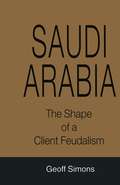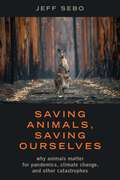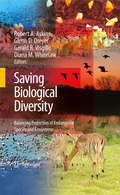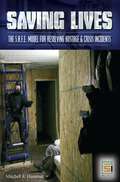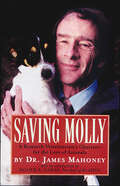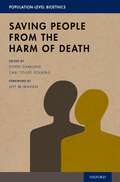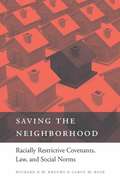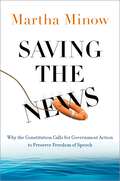- Table View
- List View
Satow's Diplomatic Practice, 8th Edition
by Sir Ivor RobertsFirst published in 1917, Satow's Diplomatic Practice has long been hailed as a classic and authoritative text. An indispensable guide for anyone working in or studying the field of diplomacy, this eighth edition builds on the extensive revisions in the sixth and seventh editions. The volume provides an enlarged and updated section on the history of diplomacy, including the exponential growth in multilateral diplomacy, and revises comprehensively the practice of diplomacy and the corpus of diplomatic and international law since the end of the Cold War. A new chapter provides extensive case studies of good and bad diplomacy. The book traces the substantial expansion in numbers both of sovereign states and international and regional organizations and features detailed chapters on diplomatic privileges and immunities, diplomatic missions, as well as consular matters, treaty-making and conferences. The volume also examines alternative forms of diplomacy, from the work of NGOs to the use of secret envoys, as well as a study of the interaction with intelligence agencies and commercial security firms. It also discusses the impact of international terrorism and other violent non-state actors on the life and work of a diplomat. The eighth edition offers a new chapter on recent developments and challenges of modern diplomacy, particularly in the light of the increasing importance and weight of China and the shock to the international system administered by Russia's invasion of Ukraine. Finally, in recognition of the speed of changes in the field over the last twenty years, it includes updated chapters on human rights and public/digital diplomacy by experts in their respective fields.
Saudi Arabia: The Shape of a Client Feudalism
by Geoff SimonsSimons describes the current human-rights situation in Saudi Arabia with reference to corruption, the treatment of dissidents, the penal system, the suppression of women, slavery and other aspects. A detailed history, from pre-Islamic times to the present, is provided, with attention to the influence of Mohammed, the Saudi ascendancy, the role of the West, the discovery of oil and the wars in the region. Finally attention is given to the various (economic/political/religious) problems that today face the Saudi regime and to the Saudi response.
Saudi Business Law in Practice: Laws and Regulations as Applied in the Courts and Judicial Committees of Saudi Arabia
by Frank VogelIn this landmark publication, the world's leading expert in the legal system of Saudi Arabia explains and documents the uncodified principles of contract, tort, and property that frame the business laws of the Kingdom. Drawing on 8,500 newly published court decisions, as well as on statutory law, interviews and a wide range of other material, the book sets out to determine the actual practice of Saudi courts in these spheres, both substantively and as to reasoning and procedure. With unique insights into and understanding of this fascinating jurisdiction, this book simply must be read by all engaged with law or business in the region. Also, given its focus on how certain Islamic legal rules and principles are applied in practice, the book will prove an invaluable resource for scholars of Islamic law past and present.
Saudi Business Law in Practice: Laws and Regulations as Applied in the Courts and Judicial Committees of Saudi Arabia
by Frank VogelIn this landmark publication, the world's leading expert in the legal system of Saudi Arabia explains and documents the uncodified principles of contract, tort, and property that frame the business laws of the Kingdom. Drawing on 8,500 newly published court decisions, as well as on statutory law, interviews and a wide range of other material, the book sets out to determine the actual practice of Saudi courts in these spheres, both substantively and as to reasoning and procedure. With unique insights into and understanding of this fascinating jurisdiction, this book simply must be read by all engaged with law or business in the region. Also, given its focus on how certain Islamic legal rules and principles are applied in practice, the book will prove an invaluable resource for scholars of Islamic law past and present.
Saudi Capital Market: Development and Challenges (International Banking and Finance Law Series)
by Bader AlkhaldiA thriving capital market, one that not only brings investment funds into a country but also distributes profits in a transparent manner, is essential for any economy, especially a rapidly developing one such as Saudi Arabia. Already a key player on the world stage, the Kingdom is going through a major planned economic transformation and diversification. In particular, a robust and transparent capital market, with a high level of integrity and sound enforcement, is well on the way to fruition. This book is the first in English to analyse and evaluate the roles of economic planning and a capital market in Saudi Arabia’s economic modernization. In the process of examining the level of transparency and fairness in Saudi Arabia’s capital market, the author provides detailed information and analysis of such issues and topics as the following: – market disclosure rules; – insider trading laws; – gaps in enforcement; – dispute resolution; – role of securities agencies; – Saudi Arabia’s position in international organizations; and – repercussions of the 2006 Saudi stock market collapse. The author draws on a wide range of sources in both English and Arabic, and concludes with well-grounded proposals for appropriate judicial, administrative, and enforcement policies. Investors, their management and attorneys, and other advisors with an eye on trade development in the Middle East will derive great benefit from the current and detailed information in this book. Lawyers and policymakers will discover all they need to know about the Saudi capital market, its developing trends, and applicable laws.
Savannah Secrets
by Fiona Hood-StewartWhen eccentric Rowena Carstairs leaves her sizable estate to an illegitimate grandson who was given up for adoption at birth, Savannah attorney Meredith Hunter is obliged to track him down.
Saving Animals, Saving Ourselves: Why Animals Matter for Pandemics, Climate Change, and other Catastrophes
by Jeff SeboIn 2020, COVID-19, the Australia bushfires, and other global threats served as vivid reminders that human and nonhuman fates are increasingly linked. Human use of nonhuman animals contributes to pandemics, climate change, and other global threats which, in turn, contribute to biodiversity loss, ecosystem collapse, and nonhuman suffering. Jeff Sebo argues that humans have a moral responsibility to include animals in global health and environmental policy. In particular, we should reduce our use of animals as part of our pandemic and climate change mitigation efforts and increase our support for animals as part of our adaptation efforts. Applying and extending frameworks such as One Health and the Green New Deal, Sebo calls for reducing support for factory farming, deforestation, and the wildlife trade; increasing support for humane, healthful, and sustainable alternatives; and considering human and nonhuman needs holistically. Sebo also considers connections with practical issues such as education, employment, social services, and infrastructure, as well as with theoretical issues such as well-being, moral status, political status, and population ethics. In all cases, he shows that these issues are both important and complex, and that we should neither underestimate our responsibilities because of our limitations, nor underestimate our limitations because of our responsibilities. Both an urgent call to action and a survey of what ethical and effective action requires, Saving Animals, Saving Ourselves is an invaluable resource for scholars, advocates, policy-makers, and anyone interested in what kind of world we should attempt to build and how.
Saving Animals, Saving Ourselves: Why Animals Matter for Pandemics, Climate Change, and other Catastrophes
by Jeff SeboIn 2020, COVID-19, the Australia bushfires, and other global threats served as vivid reminders that human and nonhuman fates are increasingly linked. Human use of nonhuman animals contributes to pandemics, climate change, and other global threats which, in turn, contribute to biodiversity loss, ecosystem collapse, and nonhuman suffering. Jeff Sebo argues that humans have a moral responsibility to include animals in global health and environmental policy. In particular, we should reduce our use of animals as part of our pandemic and climate change mitigation efforts and increase our support for animals as part of our adaptation efforts. Applying and extending frameworks such as One Health and the Green New Deal, Sebo calls for reducing support for factory farming, deforestation, and the wildlife trade; increasing support for humane, healthful, and sustainable alternatives; and considering human and nonhuman needs holistically. Sebo also considers connections with practical issues such as education, employment, social services, and infrastructure, as well as with theoretical issues such as well-being, moral status, political status, and population ethics. In all cases, he shows that these issues are both important and complex, and that we should neither underestimate our responsibilities because of our limitations, nor underestimate our limitations because of our responsibilities. Both an urgent call to action and a survey of what ethical and effective action requires, Saving Animals, Saving Ourselves is an invaluable resource for scholars, advocates, policy-makers, and anyone interested in what kind of world we should attempt to build and how.
Saving Biological Diversity: Balancing Protection of Endangered Species and Ecosystems
by Robert A. Askins Glenn D. Dreyer Gerald R. Visgilio Diana M. WhitelawThe Goodwin-Niering Center for Conservation Biology and Environmental Studies at Connecticut College is a comprehensive, interdisciplinary program that builds on one of the nation’s leading undergraduate environmental studies programs. The C- ter fosters research, education, and curriculum development aimed at understanding contemporary ecological challenges. One of the major goals of the Goodwin-Niering Center is to enhance the understanding of both the College community and the general public with respect to ecological, political, social, and economic factors that affect natural resource use and preservation of natural ecosystems. To this end, the C- ter has offered six conferences at which academicians, representatives of federal and state government, people who depend on natural resources for their living, and in- viduals from non-government environmental organizations were brought together for an in-depth, interdisciplinary evaluation of important environmental issues. On April 6 and 7, 2007, the Center presented the Elizabeth Babbott Conant interdisciplinary conference on Saving Biological Diversity: Weighing the Protection of Endangered Species vs. Entire Ecosystems. The Beaver Brook Foundation; Audubon Connecticut, the state of?ce of the National Audubon Society; the Connecticut Chapter of The Nature Conservancy; Connecticut Forest and Park Association and the Connecticut Sea Grant College Program joined the Center as conference sponsors. During this two-day conference we learned about conservation and endangered species fromawiderange ofperspectives. Likeallof theconferences sponsored bythe Goodwin-Niering Center, this conference was broadly interdisciplinary, with pres- tations by economists, political scientists, and conservation biologists.
Saving Emma: A Novel
by Allen EskensA lawyer's race to reveal a wrongful conviction collides with the dark shadow of a murder in his own home in this propulsive and perfectly-plotted thriller from "one of our best crime writers at the top of his game" (William Kent Krueger, New York Times bestselling author). When Boady Sanden first receives the case of Elijah Matthews, he&’s certain there&’s not much he can do. Elijah, who believes himself to be a prophet, has been locked up in a psychiatric hospital for the past four years, convicted of brutally murdering the pastor of a megachurch. But as a law professor working for the Innocence Project, Boady agrees to look into Elijah&’s file. When he does, he is alarmed to find threads that lead back to the death of his colleague and friend, Ben Pruitt, a man shot to death four years earlier in Boady&’s own home. Ben&’s daughter, Emma, has lived with Boady and Boady&’s wife Dee ever since that awful night. Now fourteen years old, Emma has been growing distant, and soon makes a fateful choice that takes her far from the safety of her godparents. Desperate to bring her home, and to free an innocent man, Boady must do all he can to investigate Elijah&’s case while fighting to save the family he has deeply come to love. Written with energy, propulsion, and his characteristic pathos and insight, Eskens delivers another pitch-perfect legal thriller that reveals a twisted murder and explores faith, love, family, and redemption along the way. "Ambitious, absorbing, and deeply satisfying."―Kirkus Reviews (starred review) "Eskens brilliantly combines legal and personal drama." ―Publishers Weekly (starred review) "Superb . . . another Eskens novel to be savored." ―South Florida Sun-Sentinel
Saving Human Lives: Lessons in Management Ethics (Issues in Business Ethics #21)
by Robert E. AllinsonThis is a pioneering work. Recent disasters such as the tsunami disaster continue to demonstrate Professor Allinson’s thesis that valuing human lives is the core of ethical management. His unique comparison of the ideas of the power of Fate and High Technology, his penetrating analysis of the very concept of an "accident", demonstrate how concepts rule our lives. His wide-ranging investigation of court cases and government documents from the seventeenth through the twentieth centuries, and from places as diverse as the USA, UK and New Zealand provide ample supporting evidence for the universality and the power of explanation of his thesis. Saving Human Lives will have an impact beyond measurement on the field of management ethics.
Saving Lives: The S.A.F.E. Model for Resolving Hostage and Crisis Incidents (Praeger Security International)
by Mitchell R. HammerThe standoff and ultimate tragedy in Waco, Texas, highlights the potential volatility and uncertainty of crisis negotiations and demonstrates the challenges law enforcement officials face as they attempt to resolve these situations. Hammer's book provides a practical negotiation approach (the S.A.F.E. model) that hostage negotiators and first responders can use to help save lives in situations where violence or the threat of violence is present. He identifies methods of interaction and communication during a hostage crisis that help to dispel tension and resolve situations peacefully.Combining approaches from various schools of thought on the topic, and applying the methods to both domestic and international contexts, the author has devised a model that is applicable to many types of crisis negotiations and focuses on interaction, communication, and discourse designed to bring a situation down to a manageable level. Through the analysis of several cases representing domestic, criminal, and suicidal situations, he provides a vivid roadmap to the ways in which crisis negotiation can be used to dispel violence before it takes place.
Saving Max (Mira Ser.)
by Antoinette van HeugtenMax Parkman—autistic and whip-smart, emotionally fragile and aggressive—is perfect in his mother's eyes. Until he's accused of murder.
Saving Molly: A Research Veterinarian's Choices
by James Mahoney D.V.M., Ph.D.The puppy was dying when James Mahoney found her. Molly was not the first dying animal the research veterinarian had seen. But Molly's struggle sent him barreling over rough Jamaican mountains in a borrowed car, searching for the equipment he'd need to save her. More than a story about a dog, this is the story of a rescued man. He asks himself questions: How can he spend his days with chimpanzees locked behind bars and still say that he loves them? What do we owe them for their participation in AIDS research? Why is saving a single runt puppy important? In the tradition of James Herriot, Mahoney's story spans fifty years of living with animals and with the two-legged primates who study them. Written by the man Jane Goodall called "one of the most gentle and compassionate people I know," Saving Molly is an important addition to the debate on animal research and a heartfelt meditation on one man's life. With an introduction by Roger A. Caras, president of the ASPCA."He is concerned about the pain and the suffering of the animals. That's what makes Jim Mahoney different." --Alex Pacheco, founder of PETA
Saving Nelson Mandela: The Rivonia Trial and the Fate of South Africa (Pivotal Moments in World History)
by Kenneth S. BrounThe question was: would he hang? In 1963, when South Africa's apartheid government charged Nelson Mandela with planning its overthrow, most observers feared that he would be sentenced to death. But the support he and his fellow activists in the African National Congress received during his trial not only saved his life, but also enabled him to save his country. In Saving Nelson Mandela, South African law expert Kenneth S. Broun recreates the trial, called the "Rivonia" Trial after the Johannesburg suburb where police seized Mandela. Based upon interviews with many of the case's primary figures and portions of the trial transcript, Broun situates readers inside the courtroom at the imposing Palace of Justice in Pretoria. Here, the trial unfolds through a dramatic narrative that captures the courage of the accused and their defense team, as well as the personal prejudices that colored the entire trial. The Rivonia trial had no jury and only a superficial aura of due process, combined with heavy security that symbolized the apartheid government's system of repression. Broun shows how outstanding advocacy, combined with widespread public support, in fact backfired on apartheid leaders, who sealed their own fate. Despite his 27-year incarceration, Mandela's ultimate release helped move his country from the racial tyranny of apartheid toward democracy. As documented in this inspirational book, the Rivonia trial was a critical milestone that helped chart the end of Apartheid and the future of a new South Africa.
Saving Nelson Mandela: The Rivonia Trial and the Fate of South Africa (Pivotal Moments in World History)
by Kenneth S. BrounThe question was: would he hang? In 1963, when South Africa's apartheid government charged Nelson Mandela with planning its overthrow, most observers feared that he would be sentenced to death. But the support he and his fellow activists in the African National Congress received during his trial not only saved his life, but also enabled him to save his country. In Saving Nelson Mandela, South African law expert Kenneth S. Broun recreates the trial, called the "Rivonia" Trial after the Johannesburg suburb where police seized Mandela. Based upon interviews with many of the case's primary figures and portions of the trial transcript, Broun situates readers inside the courtroom at the imposing Palace of Justice in Pretoria. Here, the trial unfolds through a dramatic narrative that captures the courage of the accused and their defense team, as well as the personal prejudices that colored the entire trial. The Rivonia trial had no jury and only a superficial aura of due process, combined with heavy security that symbolized the apartheid government's system of repression. Broun shows how outstanding advocacy, combined with widespread public support, in fact backfired on apartheid leaders, who sealed their own fate. Despite his 27-year incarceration, Mandela's ultimate release helped move his country from the racial tyranny of apartheid toward democracy. As documented in this inspirational book, the Rivonia trial was a critical milestone that helped chart the end of Apartheid and the future of a new South Africa.
Saving Nine: The Fight Against the Left's Audacious Plan to Pack the Supreme Court and Destroy American Liberty
by Mike LeeIn this national bestseller praised by Mark Levin and Sean Hannity, a leading conservative senator explains how the left&’s partisan push to pack the Supreme Court with liberal justices has fully migrated from the fringes into the mainstream of Democratic politics. It wasn&’t long ago that liberal icons, including the late Supreme Court Justice Ruth Bader Ginsburg, were against the idea of overhauling the court for political gain. But now, in the Biden era, more and more powerful Democrats are getting behind the cause, claiming the high court is broken and actively dismantling our democracy. Even Joe Biden—who once called court-packing a &“bonehead idea&”—gave in to the progressive wing of his party, appointing a committee to examine &“reforms&” to the court after being sworn in as president. In Saving Nine, Mike Lee, a brilliant legal mind, details the history of the current composition of the Supreme Court and strongly warns against the norm-shattering precedent that would be set by politically motivated attempts to turn the Supreme Court into just another partisan weapon.
Saving People from the Harm of Death (Population-Level Bioethics)
by Espen Gamlund, Carl Tollef Solberg and Jeff McMahanDeath is something we mourn or fear as the worst thing that could happen--whether the deaths of close ones, the deaths of strangers in reported accidents or tragedies, or our own. And yet, being dead is something that no one can experience and live to describe. This simple truth raises a host of difficult philosophical questions about the negativity surrounding our sense of death, and how and for whom exactly it is harmful. The question of whether death is bad has occupied philosophers for centuries, and the debate emerging in philosophical literature is referred to as the "badness of death." Are deaths primarily negative for the survivors, or does death also affect the deceased? What are the differences between death in fetal life, just after birth, or in adolescence? In order to properly evaluate deaths in global health, we must find answers to these questions. In this volume, leading philosophers, medical doctors, and economists discuss different views on how to evaluate death and its relevance for health policy. This includes theories about the harm of death and its connections to population-level bioethics. For example, one of the standard views in global health is that newborn deaths are among the worst types of death, yet stillbirths are neglected. This raises difficult questions about why birth is so significant, and several of the book's authors challenge this standard view. This is the first volume to connect philosophical discussions on the harm of death with discussions on population health, adjusting the ways in which death is evaluated. Changing these evaluations has consequences for how we prioritize different health programs that affect individuals at different ages, as well as how we understand inequality in health.
Saving People from the Harm of Death (Population-Level Bioethics)
Death is something we mourn or fear as the worst thing that could happen--whether the deaths of close ones, the deaths of strangers in reported accidents or tragedies, or our own. And yet, being dead is something that no one can experience and live to describe. This simple truth raises a host of difficult philosophical questions about the negativity surrounding our sense of death, and how and for whom exactly it is harmful. The question of whether death is bad has occupied philosophers for centuries, and the debate emerging in philosophical literature is referred to as the "badness of death." Are deaths primarily negative for the survivors, or does death also affect the deceased? What are the differences between death in fetal life, just after birth, or in adolescence? In order to properly evaluate deaths in global health, we must find answers to these questions. In this volume, leading philosophers, medical doctors, and economists discuss different views on how to evaluate death and its relevance for health policy. This includes theories about the harm of death and its connections to population-level bioethics. For example, one of the standard views in global health is that newborn deaths are among the worst types of death, yet stillbirths are neglected. This raises difficult questions about why birth is so significant, and several of the book's authors challenge this standard view. This is the first volume to connect philosophical discussions on the harm of death with discussions on population health, adjusting the ways in which death is evaluated. Changing these evaluations has consequences for how we prioritize different health programs that affect individuals at different ages, as well as how we understand inequality in health.
Saving Strangers: Humanitarian Intervention In International Society
by Nicholas J. WheelerThe extent to which humanitarian intervention has become a legitimate practice in post-cold war international society is the subject of this book. It maps the changing legitimacy of humanitarian intervention by comparing the international response to cases of humanitarian intervention in the cold war and post-cold war periods. Crucially, the book examines how far international society has recognised humanitarian intervention as a legitimate exception to the rules of sovereignty and non-intervention and non-use of force. While there are studies of each case of intervention-in East Pakistan, Cambodia, Uganda, Iraq, Somalia, Rwanda, Bosnia and Kosovo-there is no single work that examines them comprehensively in a comparative framework. Each chapter tells a story of intervention that weaves together a study of motives, justifications and outcomes. The legitimacy of humanitarian intervention is contested by the 'pluralist' and 'solidarist' wings of the English school, and the book charts the stamp of these conceptions on state practice. Solidarism lacks a full-blown theory of humanitarian intervention and the book supplies one. This theory is employed to assess the humanitarian qualifications of the cases of intervention analysed in the book, and this normative assessment is then compared to the moral practices of states. A key focus is to examine how far humanitarian intervention as a legitimate practice is present in the diplomatic dialogue of states. In exploring how far there has been a change of norm in the society of states in the 1990s, the book defends the broad based constructivist claim that state actions will be constrained if they cannot be legitimated, and that new norms enable new practices but do not determine these. The book concludes by considering how far contemporary practices of humanitarian intervention support a new solidarism, and how far this resolves the traditional conflict between order and justice in international society.
Saving the Neighborhood: Racially Restrictive Covenants, Law, And Social Norms
by Richard R. BrooksSaving the Neighborhood tells the still controversial story of the rise and fall of racially restrictive covenants in America, which bestowed an aura of legitimacy upon the wish of many white neighborhoods to exclude minorities. It offers insight into the ways legal and social norms reinforce one another, to codify and perpetuate intolerance.
Saving the Neighborhood: Racially Restrictive Covenants, Law, And Social Norms
by Richard R. BrooksSaving the Neighborhood tells the still controversial story of the rise and fall of racially restrictive covenants in America, which bestowed an aura of legitimacy upon the wish of many white neighborhoods to exclude minorities. It offers insight into the ways legal and social norms reinforce one another, to codify and perpetuate intolerance.
Saving the News: Why the Constitution Calls for Government Action to Preserve Freedom of Speech (Inalienable Rights)
by Martha MinowA detailed argument of how our government has interfered in the direction of America's media landscape that traces major transformations in media since the printing press and charts a path for reform. In Saving the News, Martha Minow takes stock of the new media landscape. She focuses on the extent to which our constitutional system is to blame for the current parlous state of affairs and on our government's responsibilities for alleviating the problem. As Minow shows, the First Amendment of the US Constitution assumes the existence and durability of a private industry. Although the First Amendment does not govern the conduct of entirely private enterprises, nothing in the Constitution forecloses government action to regulate concentrated economic power, to require disclosure of who is financing communications, or to support news initiatives where there are market failures. Moreover, the federal government has contributed financial resources, laws, and regulations to develop and shape media in the United States. Thus, Minow argues that the transformation of media from printing presses to the internet was shaped by deliberate government policies that influenced the direction of private enterprise. In short, the government has crafted the direction and contours of America's media ecosystem. Building upon this basic argument, Minow outlines an array of reforms, including a new fairness doctrine, regulating digital platforms as public utilities, using antitrust authority to regulate the media, policing fraud, and more robust funding of public media. As she stresses, such reforms are not merely plausible ideas; they are the kinds of initiatives needed if the First Amendment guarantee of freedom of the press continues to hold meaning in the twenty-first century.
Saving the News: Why the Constitution Calls for Government Action to Preserve Freedom of Speech (Inalienable Rights)
by Martha MinowA detailed argument of how our government has interfered in the direction of America's media landscape that traces major transformations in media since the printing press and charts a path for reform. In Saving the News, Martha Minow takes stock of the new media landscape. She focuses on the extent to which our constitutional system is to blame for the current parlous state of affairs and on our government's responsibilities for alleviating the problem. As Minow shows, the First Amendment of the US Constitution assumes the existence and durability of a private industry. Although the First Amendment does not govern the conduct of entirely private enterprises, nothing in the Constitution forecloses government action to regulate concentrated economic power, to require disclosure of who is financing communications, or to support news initiatives where there are market failures. Moreover, the federal government has contributed financial resources, laws, and regulations to develop and shape media in the United States. Thus, Minow argues that the transformation of media from printing presses to the internet was shaped by deliberate government policies that influenced the direction of private enterprise. In short, the government has crafted the direction and contours of America's media ecosystem. Building upon this basic argument, Minow outlines an array of reforms, including a new fairness doctrine, regulating digital platforms as public utilities, using antitrust authority to regulate the media, policing fraud, and more robust funding of public media. As she stresses, such reforms are not merely plausible ideas; they are the kinds of initiatives needed if the First Amendment guarantee of freedom of the press continues to hold meaning in the twenty-first century.
Saving the Oceans Through Law: The International Legal Framework for the Protection of the Marine Environment
by James HarrisonThe oceans cover more than seventy per cent of the surface of the planet and they provide many vital ecosystem services. However, the health of the world's oceans has been deteriorating over the past decades and the protection of the marine environment has emerged as one of the most pressing legal and political challenges for the international community. An effective solution depends upon the cooperation of all states towards achieving agreed objectives. This book provides a critical assessment of the role that international law plays in this process, by explaining and evaluating the various legal instruments that have been negotiated in this area, as well as key trends in global ocean governance. Starting with a detailed analysis of the United Nations Convention on the Law of the Sea, the book considers the main treaties and other legal texts that seeks to prevent, reduce, and control damage to the marine environment caused by navigation, seabed exploitation, fishing, dumping, and land-based activities, as well as emerging pressures such as ocean noise and climate change. The book demonstrates how international institutions have expanded their mandates to address a broader range of marine environmental issues, beyond basic problems of pollution control to include the conservation of marine biological diversity and an ecosystems approach to regulation. It also discusses the development of diverse regulatory tools to address anthropogenic impacts on the marine environment and the extent to which states have adopted a precautionary approach in different maritime sectors. Whilst many advances have been made in these matters, this book highlights the need for greater coordination between international institutions, as well as the desirability of developing stronger enforcement mechanisms for international environmental rules.

